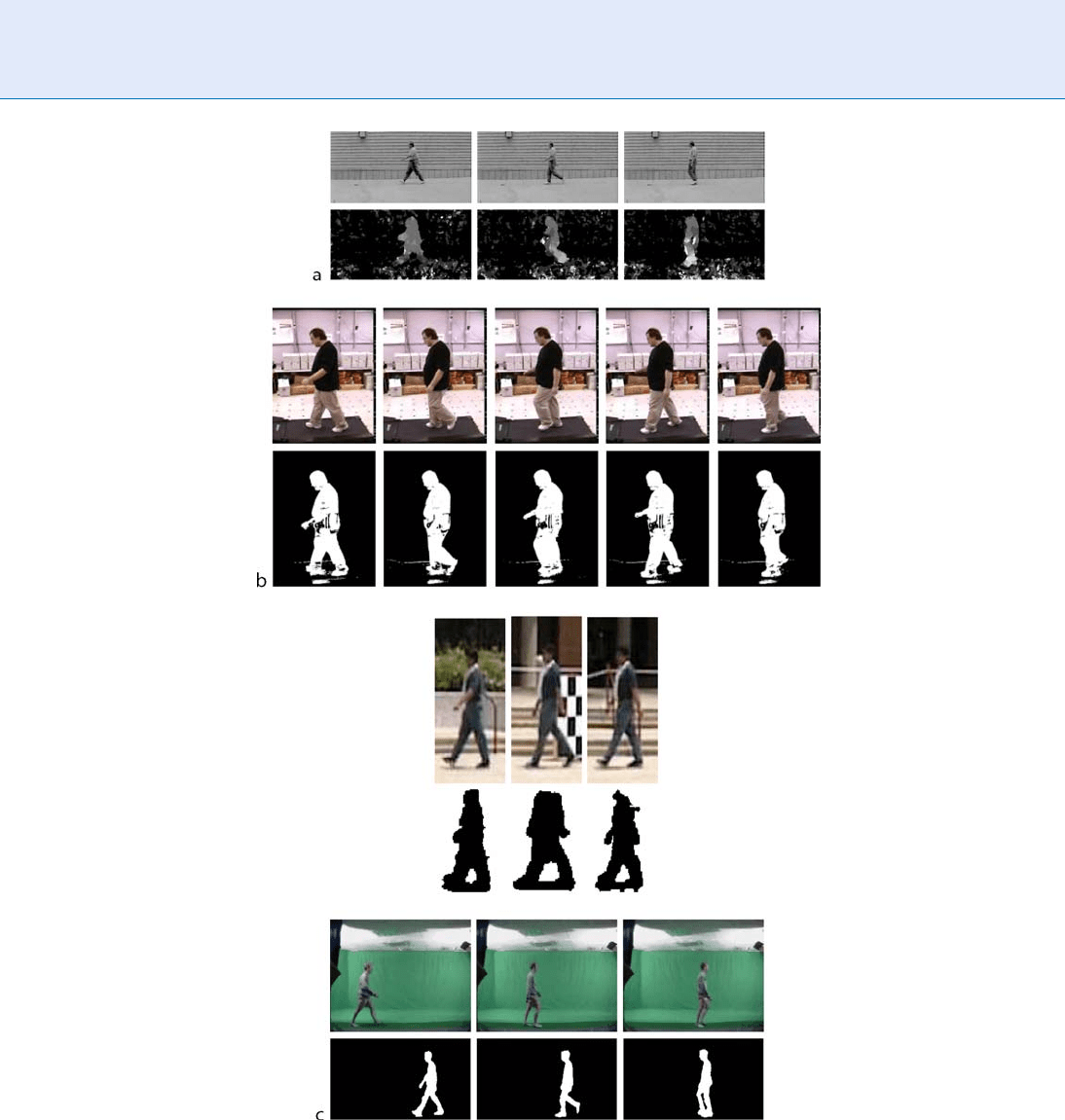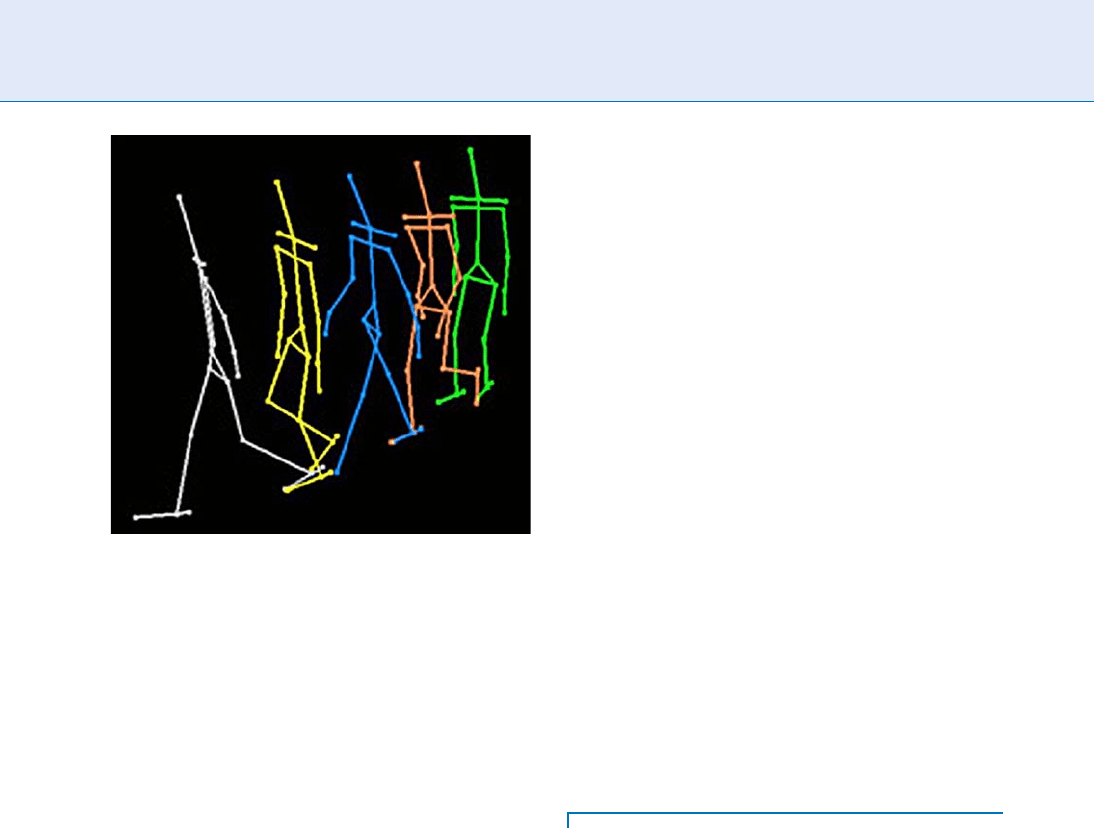Li S.Z., Jain A.K. (eds.) Encyclopedia of Biometrics
Подождите немного. Документ загружается.


The database contains samples for 122 subjects
acquired in multiple sessions and under variable con-
ditions. The challenge problem specifies a series of tests
using the database as well as a reference algorithm to
facilitate comparative testing by researchers.
Shutler et al. [25] created a database featuring
over 100 subjects (Fig. 2d). The database contains
sequences acquired over multiple sessions and features
subjects walking from both left-to-right and right-to-
left. Subjects walk on the ground or on treadmills, and
Gait Recognition, Silhouette-Based. Figure 2 Example images from gait databases suitable for testing silhouette-based
gait recognition: (a) Little and Boyd [14], (b) MOBO [21], (c) HumanID Gait Challenge [22], and (d) Shutler et al. [23].
All examples show raw video images in the top row and silhouettes or magnitude of the optical flow (Little and Boyd
only) in the bottom row. The silhouettes shown for the Shutler et al. do not correspond to the images above.
650
G
Gait Recognition, Silhouette-Based

in front of green screens (for chroma-keying) or in
outdoor scenes.
Examples
Bhanu and Han [26] estimate upper bounds on the
performance of gait recognition by equating gait with
body dimensions, presented as plots of recognition rate
versus gallery size for varying assumptions of accuracy.
As one might expect with upper bounds, these rates are
optimistic. Random guessing is a good lower bound on
performance, but any practical biometric system must
be much better. One can reasonably expect that a gait
biometric system should perform at least as well as
humans on moving light displays [2], i.e., 38% from
a gallery of six.
Within these broad bounds, there are numerous
examples of existing silhouette-based gait recognition
systems. Most of these have been tested with one
or more of the databases mentioned earlier. Examples
include the work of Hayfron-Acquah et al. [19 ],
Shutler and Nixon [17], Collins et al. [22], Bobick
and Johnson [21], Ben-Abdelkader et al. [15, 18], Liu
and Sarkar [27], Robledo and Sarkar [28]. Lee and
Grimson [29], Little and Boyd [14, 20], and Wang
et al. [30]. The best reported correct classification
rates (CCR) are better than 90% from a gallery of
approximately 100 people.
Summary
Human experience supported by psychological obser-
vation suggests that human s can be recognized by
their gaits, which inspires gait biometric systems.
Silhouette-based gait recognition systems convert
images from a video gait sequence to silhouettes of
the walker. Dynamic shape or body dimensions are
measured from the silhouettes and combined to form
a gait signature used for recognition. There are several
databases available for testing silhouette-based gait
recognition, and num erous published examples of suc-
cessful recognition using these databases.
Related Entries
▶ Gait Recognition, Model-Based
▶ Gait Recognition, Motion Analysis for
▶ Human Detection and Tracking
References
1. Boyd, J.E., Little, J.J.: Advanced Studies in Biometrics: Summer
School on Biometrics, Alghero, Italy, June 2–6, 2003, Revised
Selected Lectures and Papers (Lecture Notes on Computer Science),
vol. 3161/2005, chap. Biometric Gait Recognition, pp. 19–42.
Springer (2005)
2. Cutting, J.E., Kozlowski, L.T.: Recognizing friends by their walk:
gait perception without familiarity cues. Bull. Psychonomic Soc.
9(5), 353–356 (1977)
3. McGeer, T.: Passive dynamic walking. Int. J. Robot. Res. 9(2),
62–82 (1990)
4. McGeer, T.: Passive walking with knees. In: IEEE International
Conference on Robotics and Automation, pp. 1640–1645 (1990)
5. Kuo, A.D.: A simple model of bipedal walking predicts the
preferred speed-step length relationship. J. Biomech. Eng. 123,
264–269 (2001)
6. Kuo, A.D.: Energetics of actively powered locomotion using the
simplest walking model. J. Biomech. Eng. 124, 113–120 (2002)
7. von Tscharner, V., Goepfert, B.: Gender dependent emgs of
runners resolved by time/frequency and principal pattern analy-
sis. J. Electromyogr. Kines. 13, 253–272 (2003)
8. Baumberg, A.M., Hogg, D.C.: Generating spatiotemporal mod-
els from examples. In: Sixth British Conference on Machine
Vision, Vol. 2, pp. 413–422. Birmingham, UK (1995)
9. Brinkmann, R.: The Art and Science of Digital Compositing.
Morgan-Kaufmann, San Diego, CA (1999)
10. Stauffer, C., Grimson, W.E.L.: Adaptive background mixture
models for real-time tracking. In: Computer Vision and Pattern
Recognition, vol. II, pp. 246–252. Fort Collins, CO, USA (1998)
11. Barron, J.L., Fleet, D.J., Beauchemin, S.: Performance of optical
flow techniques. Int. J. Comput. Vision 12(1), 43–77 (1994)
12. Troje, N.F.: Decomposing biological motion: a framwork for
analysis and synthesis of human gait patterns. J. Vision 2,
371–387 (2002)
13. Omlor, L., Giese, M.A.: Extraction of spatio-temporal primitives
of emotional body expressions. Neurocomputing 70(10–12),
1938–1942 (2007)
14. Little, J.J., Boyd, J.E.: Recognizing people by their gait: the shape
of motion. Videre 1(2), 1–32 (1998)
15. Ben-Abdelkader, C., Cutler, R., Davis, L.: Person identification
using automatic height and stride estimation. In: 16th Interna-
tional Conference on Pattern Recognition, pp. 377–380. Quebec,
Quebec (2002)
16. Ballard, D.H., Brown, C.M.: Computer Vision. Prentice-Hall,
Englewood Cliffs, NJ (1982)
17. Shulter, J.D., Nixon, M.S.: Zernike velocity moments for
sequence-based descriptiion of moving features. Image and Vi-
sion Computing 24, 343–356 (2006)
18. Ben-Abdelkader, C. Cutler, R., Davis, L.: Motion-based recogni-
tion of people in eigengait space. In: 5th IEEE International
Conference on Automatic Face and Gesture Recognition, 267–
272 (2002)
19. Hayfron-Acquah, J.B., Nixon, M.S., Carter, J.N.: Automatic gait
recognition by symmetry analysis. Pattern Recogn. Lett. 24,
2175–2183 (2003)
20. Boyd, J.E.: Synchronization of oscillations for machine perception
of gaits. Comput. Vision Image Understand. 96, 35–59 (2004)
Gait Recognition, Silhouette-Based
G
651
G

21. Bobick, A., Johnson, A.: Gait recognitin using static activity-
specific parameters. In: Computer Vision and Pattern Recogni-
tion 2001, Vol. I, pp. 423–430. Kauai, HI (2001)
22. Collins, R.T., Gross, R., Shi, J.: Silhouette-based human identifi-
cation from body shape and gait. In: Automatic Face and Ges-
ture Recognition, pp. 351–356. Washington DC (2002)
23. Gross, R., Shi, J.: The cmu motion of body (mobo) database.
Tech. Rep. CMU-RI-TR-01-18, Robotics Institute, Carnegie
Mellon University (2001)
24. Sarkar, S., Phillips, J., Liu, Z., Robledo, I., Prother, P., Bowyer, K.
W.: The humanid gait challenge problem: data sets, perfor-
mance, and analysis. IEEE Trans. Pattern Analy. Mach. Intell.
27(2), 162–177 (2005)
25. Shutler, J., Grant, M., Nixon, M., Carter, J.: On a large sequence-
based human gait database. In: Fourth International Conference
on Recent Advances in Soft Computing, pp. 66–71. Nottingham,
UK (2002)
26. Bhanu, B., Han, J.: Bayesian-based performance prediction for
gait recognition. In: IEEE Workshop on Motion and Video
Computing, pp. 145–150. Orlando, Florida (2002)
27. Liu, Z., Sarkar, S.: Improved gait recognition by gait dynamics
normalization. IEEE Trans. Pattern Analy. Mach. Intell. 28(6),
863–876 (2006)
28. Robledo, I., Sarkar, S.: Statistical motion model based on
the change of feature relationships: human gait-based recogni-
tion. IEEE Trans. Pattern Analy. Mach. Intell. 25(10), 1323–1328
(2003)
29. Lee, L., Grimson, W.: Gait analysis for recognition and classifi-
cation. In: Automatic Face and Gesture Recognition, pp.
148–155. Washington DC (2002)
30. Wang, L., Tan, T., Ning, H., Hu, W.: Silhouette analysis-based
gait recognition for human identification. IEEE Trans. Pattern
Analy. Mach. Intell. 25(12), 1505–1518 (2003)
Gait, Forensic Evidence of
NIELS LYNNERUP,PETER K. LARSEN
Laboratory of Biological Anthropology, Institute of
Forensic Medicine, University of Copen hagen,
Copenhagen, Denmark
Synonyms
Gait analysis; Perpetrator identification
Definition
Forensic evidence of gait, or forensic gait analysis, may
be defined as analyses of gait performed in the service
of the law. Usually, this involves analyses of criminal
cases with the aim to characterize the gait of a perpe-
trator, and often to compare the gait of a perpetrator
with the gait of a suspec t. The results of the analyses
may furthermore need to be presented in cour t. The
methods involved in forensic gait analyses comprise
morphological assessment of single gait features and
kinematic assessment of body movement, often com-
bined with photogrammetrics. The latter means that
body segment leng ths, stride length, etc. may be quan-
tified and used in direct comparisons.
Introduction
Forensic analysis of ▶ gait has a lot of common ground
with biometric gait recognition, but there are also some
major differences. In terms of image capture, the imag-
ery used in forensic gait analysis is mostly always ac-
quired from CCTV, with the perpetrator specifically
trying to conceal identity. In biometric systems, image
capture of a person, or registration, takes place under
specific circumstances, designed to maximize data
quality, and obviously a person will willingly follow a
set of guidelines in order to ensure proper registration.
On the other hand a bank robber might try to hide his
or her face to avoid facial recognition or wear baggy
clothes to blur body morphology.
Biometric gait recognition systems may operate
with various false accept or reject rates, which govern
how exclusive the system is, and reflect the number of
‘‘wrong’’ registrations that can be tolerated. For exam-
ple, a relatively high false reject rate (i.e., rejecting a
person who otherwise should be cleared) is not a
problem if the system is meant for a screening func-
tion, where rejection simply leads to an additional
identity check. It is possible to generate computer
models w hich can identify people by their gait with
more t han 90% success [1, 2], but these models are still
based on a small number of people and require optimal
conditions seldom found outside the laboratory [3].
Alternative biometric approaches use a description of a
subject’s silhouette, often with reportedly improved
recognition performance [4]. In forensic gait analysis,
the analysis is often specifically carried out to match a
perpetrator w ith a suspect. If the case is made that
there is a match then the suspect may be sentenced.
This places a certain onus on the gait analysis and the
scientists carrying out the analyses, and the prosecution
and the defense may well challenge the findings of the
652
G
Gait, Forensic Evidence of

gait analysis. This also means that when presenting
the results of a forensic gait analysis, one has to be
familiar with the legal prerequisites for the legal state-
ments, and how expert evidence is adjudicated.
Technical Issues
Bank CCTV systems are often set up not to capture gait
specifics, but rather to give fields of view covering
office spaces, teller machines, etc., and also often to
supervise the bank employees. It is a not uncommon
experience when perusing CCTV footage after a bank
robbery that the perpetrator is seen moving behind
desks and tellers, so that only the upper part of his
body is filmed. Also, the CCTV system may vary quite
a lot in terms of technical quality, e.g., image capture
frequencies, digital versus analog data storage, color
versus b/w cameras (the latter often of sharper quality),
and numerous supplier – dependent video and com-
puter systems (e.g., in terms of data compression of
video images).
The recording frequency should ideally be about
15 Hz allowing the examination of dynamic features
such as, e.g., lateral instability in the knee at heel strike.
Others have found a similar frequency sufficient for
obtaining joint angles [5] and for automatic recogni-
tion of gait [2]. Lower recording frequencies may also
be sufficient to examine features that are more static,
although the gait will have a ‘‘jerky’’ appearan ce. Even
at a low 5 Hz recording frequency, it has proved possi-
ble to examine gait parameters such as dorsal/plantar
flexion at heel strike, degree of ‘‘push-off’’ at toe-off,
and knee flexion during stance. At even lower record-
ing frequencies, where the images really are still image
series, specific gait-related characteristics may be no-
ticed, e.g., a perpetrator with a bow-legged left knee.
This means that even just one single image of the gait
can sometimes be useful, if the gait feature captured
can be deemed characteristic.
Gait
The ability to recognize other individuals is fundamen-
tal to human life. Identification by gait is a part of
this process. Shakespeare made use of this in his play
‘‘The Tempest’’ where Ceres said: ‘‘High’st queen of
state, Great Juno, comes; I know her by her gait’’.
Psychophysiological studies have proved that the
human being can recognize the sex of a walker [6]
and friends and colleagues [7, 8] with a success rate
up to 70–80%.
The authors derive from the Institution that
has conducted what are, so far, the only scientific
approaches to gait analysis for evidential procedures.
The essay describes how evidential analysis was derived
and presented in two forensic investigations [ 9, 10].
Gait analyses is performed by first gaining a purely
morphological,
▶ anthroposcopic impression of the
gait of a perpetrator. We then combine the basic ability
to recognize people with biomechanical knowledge in
order to give statements as to whether a suspect could
have the same identity as a perpetrator in a given case
by comparing the suspect’s posture and joint angles
during gait with the perpetrator’s. A checklist has been
developed for forensic gait analysis (Table 1). First
described are the general characteristics of the perpe-
trator’s gait following which are analyzed each of the
joint rotations and segment movements found relevant
for forensic gait analysis (by trial end error). When a
profile of the perpetrator has been completed, each
item of the list is compared to the recording of the
suspect and stated if agreement (A), no agreement (N),
or comparison not possible (-) is found. An item can
be incomparable because either the joint rotation/
movement cannot be analyzed due to poor quality of
the surveillance recordings, or the recording of the
suspect differs too much in some way from the record-
ing of the crime such as differences in shoulder angles
between suspect and perpetrator because of elevated
shoulders in one of the recordings.
There have been several automated assessments of
feature analysis for forensic and biometric purp oses
which show that there is a natural match between
technique and observed performance [ 5]. Their fea-
tures include foot angle (degree of outward rotation),
the step length, and the mean hip joint angle, among
others. Several other characteristic features have also
been identified: inversion/eversion in the ankle during
stance, lateral flexion in the dorsal column of the
spine, and the knee angle in the frontal plane that
would show lateral instability of the knee and signs
of a person being bow-legged/knock-kneed. Further-
more, some of the characteristic features found were
so special, such as limping, that it was not necessarily
expected to be found in the 11 randomly selected
subjects.
Gait, Forensic Evidence of
G
653
G

It should be stressed that a rather wide definition
of ‘‘gait analysis’’ is used, so that basically all bodily
movements may be studied. Posture and stance may be
quite specific. For example, when standing, one leg is
more often weight-bearing than the other; there may
be marked lordosis; the neck and shoulders may be
more or less slouched, and so on. These stance-related
characteristics have a bearing on how a person initiates
or stops walking, and should thus also be involved in
the analysis.
All the above features may be judged purely mor-
phologically, but it may be of great evidentiary value to
attach numbers to these features. Thus, the morpho-
logical approach is combined with photogrammetry in
order to acquire specific measurements of body seg-
ment lengths and heights.
Photogrammetry in Association with
Gait Analysis
Photogrammetry literally means measuring by pho-
tography. Photogrammetry enables the measurement
of unknown values in two-dimensional space (2D)
using known values within a single image [ 9, 10].
Another basic application of photogrammetry is mea-
suring objects in three-dimensional space (3D) using
photographs taken from different sides and angles.
Zhao et al. [11] have also worked with video sequences
in this respect. Jensen and Rudin [9] used a 2D method
to measure the stature and several segment lengths in
two different cases and found excellent agreement be-
tween perpetrator and suspect. Lynnerup and Vedel
[10, 12] used a 3D method in the investigation of a
bank robbery where the perpetrator was recorded si-
multaneously from two different cameras and found
good agreement in bodily measurements when com-
paring the perpetrator to the suspect.
A first step in photogrammetry is calibration of
the CCTV cameras. This is done by placing frames
with targets on the locations (Fig. 1). The frames
are photographed with both the surveillance video
cameras and a calibrated digital camera. Using the
digital camera images and special software (PhotoMo-
deler Pro
1
) the points are measured and subsequently
imported as control points (‘‘fiduciary points’’). A
feature in PhotoModeler Pro
1
allows determination
of the internal parameters of the surveillance video
cameras, e.g., focal length, and subsequent calculation
of the exact placement of the cameras. After calibration,
still images from the surveillance cameras are input in
PhotoModeler Pro
1
. The photogrammetrical method
described here has the advantage that there is no need
Gait, Forensic Evidence of. Table 1 IFM Copenhagen
gait description form/checklist. The rightmost column is
marked up either with ‘‘A’’ for agreement; ‘‘N’’ for no
agreement; and ‘‘-’’ for incomparable (see text).
The middle column is used for notes and specific
observations
General
Notes on gait of
perpetrator/
suspect
Long/short steps, stiff/
relaxed gait with Narrow/
wide distance between
the feet
Signs of pathologic gait
Feet/ankle joint
Outward rotation
Inversion/eversion
Dorsal/plantar flexion at
heel strike
Degree of ‘‘push-off’’ at
toe-off
Knee
Varus/valgus
Knee flexion during stance
Hip/pelvis
Pelvis Abduction/adduction
Pelvis Rotation
Pelvis tilt
Upper body
Lateral flexion of spinal
column
Forward/backward leaning
Rotation of the upper body
during walk
Shoulders
Angle in frontal plane
Forward/backward rotation
Neck/head
Posture in sagittal plane
Head movements in frontal
plane
Quality of recordings/
other precautions
654
G
Gait, Forensic Evidence of

to ascertain the position of the perpetrator in relation
to a measuring device. After calibration by fiduciary
points, the photogrammetrical analysis produces
points in a 3D space, and an evaluation of the goodness
of fit may be made directly in the software. This then
allows measuring body segment lengths, stature, etc. of
a perpetrator in various locations and with various
body stances (Fig. 2). The selection of anatomical
points is done by choosing specific points such as the
top of the head, eyes, and joint center-points on an
image. This selection is made by judging anatomical
landmarks, clothing displacement, comparison with
images just before and after the chosen photo, etc.
When then focusing on the other images of the same
situation, but from other cameras, the program will
indicate the epi-lines (the ‘‘line of sight’’) from the first
image, as well as a line connecting the two joints. After
selecting the identical anatomical points in this image ,
it is immediately apparent how good the fit is, and
whether the points selected in the first image are ade-
quate. Thus, the 3D coordinates are calculated not only
by a simple averaging of points chosen from two
images, but reflect a dynamic process where the tight-
ness of the intersections of the epi-lines is minimized.
The absolute error associated with measuring using
photogrammetry as described is small. For instance,
the height of a desk (bolted to the floor and not moved
between the incident and the analysis) was measured
by photogrammetry (result: 89.3 cm) and compared to
Gait, Forensic Evidence of. Figure 1 Measuring screens
put up in a department store, in order to calibrate the
CCTVs [10].
Gait, Forensic Evidence of. Figure 2 Screen shots of PhotoModeler Pro
1
interface, showing selection of points.
Simultaneous images from different CCTV cameras are used to pinpoint concurrent anatomical points (and markers) seen
from different POV. The lines between the points are to scale and thus hold accurate measures of distance [10].
Gait, Forensic Evidence of
G
655
G

an actual physical measurement (result: 90.0 cm), thus
the error was 7 mm or less than 1%. Intra- and inter-
observer tests of photogrammetric measurements of
bodily segments seem to indicate that the error asso-
ciated with clearly identifiable body points, such as top
of the head, eyes, ear lobes, among others is small. On
the other hand, if the body points are hidden or ob-
scured by clothing, such as joint center-points, then
there is some variation, which nee ds to be taken into
account.
Currently, research focuses on implementing the
possibility of performing accurate measurements
of a perpetrator even though images are from only
one camera. To do this, a measuring screen is used,
the contours of which can be accurately measured
by th e software, which is physically placed near to
where the perpetrator was standing (it nee ds to
place the perpetrator on a specific point o n the
floor). If the screen is oriented perpendicular to
the camera, then the screen can be imported as a
virtual screen overlaid the crime video-footage
(Fig . 3). The perpetrator can then be measured against
this screen, akin to seeing a person standing in front
of a light-source, and whose shadow is cast of a screen
or wall behind him.
Comparing Gait and Photogrammetry
As the forensic analysis mostly pertains to comparisons
of perpetrators and suspects, then gait analyses and
measuring of the suspect also has to be carried out.
Owing to legal exigencies, this may be performed
under very different settings and conditions, compris-
ing hidden and overt image capture for gait, and
hidden and overt photogrammetry. In some cases,
legal circumstances have ruled out hidden image cap-
ture; in other cases the defense counsel was invited to
be present (but without the knowledge of the suspect);
and finally, the suspect has sometim es been filmed
completely overt. Ideally, it is felt that gait image cap-
ture should be performed hidden, so as the suspect
does not know he is being filmed. This is to ensure that
the gait is not ‘‘changed’’. Preferably, the setting for
performing the image capture should to some extent
mimic the crime scene. For example, if at the crime
scene there was a step at the entrance, which the
suspect engaged in a distin ct fashion, then filming
the suspect engaging a somewhat likewise step would
be obvious for comparison. If the crime scene images
show a perpetrator walking down a corridor, either
against or away from the CCTV camera, then a setting
at police offices with a long corridor may be suitable.
The filming usually takes place with ordinary DV-
cameras, and is done by forensic technicians, but the
setting would have been discussed in advance. For
instance, a policeman can be instructed to accompany
the suspect, but walking at a speed that matches the
velocity of the perpetrator, because the gait speed may
influence some of the features. For example, a lateral
instability in the knee will be more pronounced at a
higher gait speed.
Gait, Forensic Evidence of. Figure 3 Using the back-projection screen method (see text).
656
G
Gait, Forensic Evidence of

The photogrammetric measurement of the suspect
is most easily performed overtly. Usually a corner in an
office is identified with points fixed on the wall, and
the suspect is asked to stand in the corner. Using two or
three digital cameras, coupled to a computer, several
sets of images of high quality for subsequent photo-
grammetry can be rapidly acquired. While height
could be just as easily acquired using a stadiometer,
it is found that the same measuring method (photo-
grammetry) should be used for comparing perpetrator
and suspect. While at first glance stadiometer-measured
stature might seem as a ‘‘gold-standard’’, it is also found
that people almost automatically straighten themselves
when asked to stand against a stadiometer, meaning in
fact that a better agreement between subsequent measur-
ings of stature by photogrammetry has been found, than
between photogrammetry and a stadiometer. Of course,
measuring the suspect by photogrammetry also makes
it easier to measure other heights, such a floor to eye,
floor to shoulder, and floor to ear-lobe.
Scho
¨
llhorn et al. [13] concluded that ‘‘identifica-
tion of individuality seems to be impossible with single
variables or specific parameters of single variables’’, so
the more gait characteristics and bodily measurements
of the perpetrator that can be extracted and compared
to the suspect, the better.
The Nature of Forensic Statements
In statements to the police it is noted what image mate-
rial has been available, and what manner of image
enhancing techniques had been used. The results of the
above analyses are then presented, each followed by a
separate conclusion, and each conclusion always sum-
ming up what features were found to indicate concor-
dance between the suspect and the perpetrator, as well as
features which seemed to indicate incongruity. Each
item may therefore be seen as constituting single pieces
of evidence. This renders a statistical approach, for
instance the calculation of likelihood ratios for identity,
based on the prevalence of certain facial and bodily traits,
problematical [14].
Using the data sheets for gait analyses and photo-
grammetry fulfils three of the four guidelines in
the
▶ Daubert Standard, a legal precedent set by Su-
preme Court of the United States [15], for determining
whether expert witnesses’ testimony is admissible as
evidence: (1) the testimony in court is based on an
empirically used technique, (2) the technique has
been published in peer-reviewed literature and (3) it
is generally accepted for use in forensic medicine. The
last Daubert Guideline states that the reliability of
the technique has been tested and potential error
rates known.
Image based comparison will probably never achieve
specific identification such as associated with DNA-
typing and fingerprinting. However, analyzing gait
and measuring stature and segment lengths of a perpe-
trator from surveillance video has the possibility of
becoming a valuable forensic tool because the gait and
the measures are an integrated part of the offender.
At present, the methods can be used effectively to
exclude a suspect if the gait and anthropometrical mea-
sures of the suspect and perpetrator are entirely different
from each other. On the other hand, if the perpetrator
and suspect do have a similar gait and similar measures,
it can only be stated in court that the suspect cannot be
excluded as the perpetrator. To give a more specific
statement of the value of evidence, a database with gait
characteristics and measures for a population of which
the perpetrator and suspect could be referenced against.
In theory, this might mean that if a perpetrator and a
suspect are measured to have an unusual height, i.e.,
either very tall or very small, then this might in itself
increase the likelihood of concordance between them,
whereas very average heights would lower the likelihood
(because then it might be almost anybody). In actuality,
such databases are rather restricted, with often only
specific subsamples of the entire population repre-
sented; populations also change in terms of e.g., immi-
gration; and finally the perpetrator might well be from
an entirely different part of the world. If comparing with
such databases, it is important to stress that ‘‘given the
perpetrator/suspect are drawn from the same popula-
tion as the database’’, then their stature is more or less
common, and the likelihood of concordance between
them is more or less likely.
Future work will probably focus on a better inte-
gration of gait characteristics and photogrammetry in
order to perform dynamic measurements of gait (basi-
cally ‘‘animating’’ the line models, cf. Fig. 4). This has
the potential of calculating angles of flexion – exten-
sion in the major joints, step length, degree of side-to-
side movement of the torso during walking, etc. These
parameters may then further assist in discriminating
between suspects and more specifically in identifying
individual traits of gait.
Gait, Forensic Evidence of
G
657
G

Related Entries
▶ Gait Recognition, Model-Based
▶ Gait Recognition, Motion Analysis for
▶ Gait Recognition, Overview
▶ Gait Recognition, Silhouette-Based
References
1. Cunado, D., Nixon, M.S., Carter, J.N.: Automatic extraction and
description of human gait models for recognition purposes.
Comput. Vis. Image Underst. 90, 1–41 (2003)
2. Urtasun, R., Fua, P.: 3D tracking for Gait Characterization and
Recognition. 1Computer Vision Laboratory. Swiss Federal Insti-
tute of Technology, Lausanne, Switzerland. Report No. IC/2004/
04(2004)
3. Nixon, M.S., Tan, T.N., Chellappa, R.: Human identification
based on gait. Springer Science + Business Media, Inc. New
York, NY, USA (2006)
4. Rahati, S., Moravejian, R., Kazemi, F.M.: Gait Recognition
Using Wavelet Transform Information Technology: New Gen-
erations, 2008. Fifth International Conference on Information
Technology. pp. 932–936. 7–9, proceedings, Universitat Triet,
Germany (April 2008)
5. Wagg, D.K., Nixon, M.S.: On automated model-based extraction
and analysis of gait, Proceedings of the Sixth IEEE International
Conference on Automatic Face and Gesture Recognition, IEEE
Seoul, Korea. 11–19. 17–19 (May 2004)
6. Kozlowski, L.T., Cutting, J.E.: Recognizing the sex of a walker
from a dynamic point-light display. Percept. Psychophys. 21,
575–580 (1977)
7. Cutting, J.E., Kozlowski, L.T.: Recognizing friends by their walk:
Gait perception without familiarity cues. Bull. Psychon. Soc. 9,
353–356 (1977)
8. Jokisch, D., Daum, I., Troje, N.F.: Self recognition versus recog-
nition of others by biological motion: viewpoint-dependent
effects. Perception 35(7), 911–920 (2006)
9. Jensen, S.C., Rudin, L.I.: Measure: an interactive tool for accu-
rate forensic photo/videogrammetry. In: Rudin, L.I., Bramble,
S.K. (eds.) Investigative and Trial Image Processing 1995 July 13;
73–83. SPIE, San Diego, CA (1995)
10. Lynnerup, N., Vedel, J.: Person identification by gait analysis and
photogrammetry. J. Foren. Sci. 50(1), 112–118 (2005)
11. Zhao, G., Liu, G., Hua, L., Pietikainen, M.: 3D gait recognition
using multiple cameras. In Automatic Face and Gesture Recog-
nition, 2006. FGR 2006. Seventh International Conference,
10–12 April 2006: 529–534 (2006)
12. Lynnerup, N., Sejrsen, B., Vedel, J.: Identification by facial rec-
ognition, gait analysis and photogrammetry: The Anna Lindh
murder. In: Brickley, M., Ferllini, R. (eds.) Forensic Anthropol-
ogy: Case studies from Europe, pp. 232–244, Charles C. Thomas,
Springfield, Ill., U.S.A. (2007)
13. Aitken, C.G.G.: Statistics and the evaluation of evidence for
forensic scientists. Wiley and Sous, Chichester, UK (1995)
14. Daubert v. Merrell Dow Pharmaceuticals, Inc., 509 U.S. 579 (1993)
15. Schollhorn, W.I., Nigg, B.M., Stefanyshyn, D.J., Liu, W.: Identi-
fication of individual walking patterns using time discrete and
time continuous data sets. Gait Posture 15(2), 180–186 (2002)
Gallery and Probe
Gallery is one of the data partitions in an algorithm-
level biometric evaluation experiment. It is a collection
of biometric templates that form the search dataset.
Typically, these are representative of the enrolled tem-
plates in an actual biometric deployment scenario. In
algorithm-level evaluations, care should be taken to
have same number of representative templates per
subject in the gallery. Probe is the second data partition
in an algorithm-level evaluation experiment. It is a
collection of biometric templates that need to be recog-
nized or identified by matching against the gallery. In
any given algorithm-level evaluation, the probes and
gallery differ with respect to the covariate that is being
studied. For example, to study the impact of viewpoint
covariate, the gallery is chosen to be from one view-
point and the probe is chosen to be from a different
viewpoint. Since during actual operations biometric
data is expected to arrive in a sequential fashion, it is
not appropriate to normalize or adjust biometric
Gait, Forensic Evidence of. Figure 4 Line models
produced by the Photomodeler
1
based on the selected
anatomical points, showing the gait.
658
G
Gallery and Probe

matching scores over the probes. Neither is it appro-
priate to train on the probe data.
▶ Evaluation of Gait Recognition
Gaussian Mixture Density
▶ Gaussian Mixture Models
Gaussian Mixture Models
DOUGLAS REYNOLDS
Lincoln Laboratory, MIT, Lexington, MA, USA
Synonyms
Gaussian mixture density; GMM
Definition
A Gaussian Mixture Model (GMM) is a parametric
▶ probability density function represented as a weight-
ed sum of Gaussian component densities. GMMs are
commonly used as a paramet ric model of the pro-
bability distribution of continuous measurements or
features in a biometric system, such as vocal-tract
related spectral features in a speaker recognition
system. GMM parameters are estimated from training
data using the iterative Expectation-Maximization
(EM) algorithm or
▶ Maximum A Posteriori (MAP)
estimation from a well-trained prior model.
Introduction
A Gaussian mixture model is a weighted sum of M
component Gaussian densities as given by the equation,
pðxjlÞ¼
X
M
i¼1
w
i
gðxjm
i
; S
i
Þ; ð1Þ
where x is a D-dimensional continuous-valued data
vector (i.e. measurement or features), w
i
, i ¼ 1, ..., M,
are the mixture weights, and gðxjm
i
; S
i
Þ, i =1,..., M
are the component Gaussian densities. Each compo-
nent density is a D-variate Gaussian function of the
form,
gðxjm
i
; S
i
Þ¼
1
ð2pÞ
D=2
jS
i
j
1=2
exp
1
2
ðx m
i
Þ
0
S
1
i
ðx m
i
Þ
;
ð2Þ
with mean vector m
i
and covariance matrix S
i
.
The mixture weights satisfy the constraint that
P
M
i¼1
w
i
¼1.
The complete Gaussian mixture model is parame-
terized by the mean vectors, covariance matrices and
mixture weights from all component densities. These
parameters are collectively represented by the notation,
l ¼fw
i
; m
i
; S
i
g i ¼ 1; ...; M: ð 3Þ
There are several variants on the GMM shown in
Eq. (3). The covariance matrices, S
i
, can be full rank or
constrained to be diagonal. Additionally, parameters
can be shared, or tied, among the Gaussian compo-
nents, such as having a common covariance matrix for
all components, The choice of model configuration
(number of components, full or diagonal covariance
matrices, and parameter tying) is often determined by
the amount of data available for estimating the GMM
parameters and how the GMM is used in a particular
biometric application.
It is also important to note that since the compo-
nent Gaussian are acting together to model the overall
feature density, full covariance matrices are not neces-
sary even if the features are not statistically indepen-
dent. The linear combination of diagonal covariance
basis Gaussians is capable of modeling the correla-
tions between feature vector elements. The effect of
using a set of M full covariance matrix Gaussians can
be equally obtained by using a larger set of diagonal
covariance Gaussians.
GMMs are often used in biometric systems, most
notably in speaker recognition systems [1, 2], due to
their capability of representing a large class of sample
distributions. One of the powerful attributes of the
GMM is its ability to form smooth approximations
to arbitrarily shaped densities. The classical unimodal
Gaussian model represents feature distributions by a
position (mean vector) and a elliptic shape (covariance
matrix) and a vector quantizer (VQ) or nearest neigh-
bor model represents a distribution by a discrete set
Gaussian Mixture Models
G
659
G
